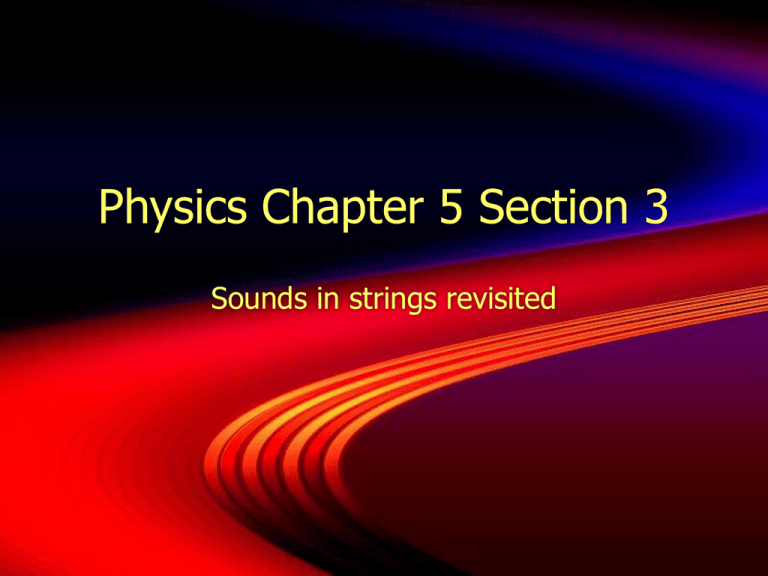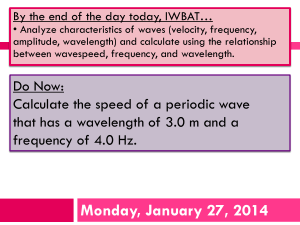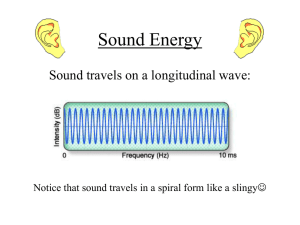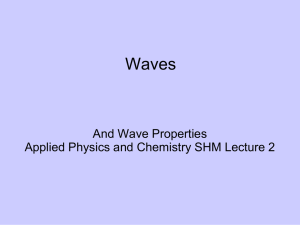Physics Chapter 5 Section 3
advertisement

Physics Chapter 5 Section 3 Sounds in strings revisited HW: p 517 #1-5 Learning Objective Explain direct and inverse relationships Explain how wave speed, wavelength, and frequency are related Create a data table to organize data for experiments. Success Criteria Describe what determines wavelength and sound Describe the relationship between tension and speed of a wave Describe the relationship between wavelength and frequency Determine the velocity of a wave using the equation Calculate wavelength of a standing wave Describe how the pitch of the sound produced by a vibrating string depends on the wave speed, wavelength and frequency of the waves on the string. Do Now: Write LO and SC on new left page WDYS/WDYT on page 508 Agenda Do Now Investigation 5.3 Summary/Exit Ticket Investigate 5.3 Same set-up as Investigation 1 What kind of wave is the string making? How do you calculate wavelength? (Guidelines for 1-7) Standing Wave - this is similar to the waves made in the spring The wavelength is twice the length of the string Sample Data Table String Length Wavelength (2x string length) Pitch (high, low, or medium) Investigation 5.3 Complete with your group Remember that speed is distance traveled over a period of time. (Guidelines for 8-12) d s t Summary/Exit Ticket How does changing the wavelength effect the velocity? How does changing the frequency effect the velocity? HW: p 517 #1-5 Learning Objective Explain direct and inverse relationships Explain how wave speed, wavelength, and frequency are related Create a data table to organize data for experiments. Success Criteria Describe what determines wavelength and sound Describe the relationship between tension and speed of a wave Describe the relationship between wavelength and frequency Determine the velocity of a wave using the equation Calculate wavelength of a standing wave Describe how the pitch of the sound produced by a vibrating string depends on the wave speed, wavelength and frequency of the waves on the string. Do Now: If you keep the wavelength the same, how can you change the velocity of the wave? Agenda Do Now Notes 5.3 Summary/Exit Ticket Physics Talk 5.3 What kind of wave does the vibrating string produce? A standing wave How do you calculate the wavelength? The wavelenght is twice the length of the string Physics Talk 5.3 How does frequency relate to pitch? The higher the frequency, the higher the pitch Equation for wave speed Wave speed = wave frequency x wavelength v f Physics Talk 5.3 How do we solve for frequency? Rearrange the equation to read f v Physics Talk 5.3 What happened when you shortened the length of the string? The wavelength was shortened Pitch increased Frequency increased How is this shown in the equation? Dividing by a smaller number on the bottom, gives us a larger frequency If you have to share something with fewer people, you get more Physics Talk 5.3 What kind of mathematical relationship does this show? Inverse Relationship What is an inverse relationship? A relationship where when one value increases, the other decreases, or as one value decreases, the other increases Physics Talk 5.3 How is frequency an example of an inverse relationship? Decreasing the wavelength increases the frequency Physics Talk 5.3 How are tension and pitch related? Since the wavelength did not change, and the frequency increased, this means the wave speed increased An increase in tension, produces a larger force, which leads to a larger acceleration on the string (F=ma) Physics Talk 5.3 How are tension and pitch related? (continued) When the force accelerates the string, the wave speed increases and the string vibrates faster Since the wave is faster, the frequency must also be faster, leading to a higher pitch Physics Talk 5.3 What is a direct relationship? A relationship where as one value increases, the other value also increases Example of direct relationship Increasing the wave speed also increases the frequency and pitch Physics Talk 5.3 How does increasing the thickness of the string lead to a different pitch? When the string is larger, it has a greater mass for the wave to travel through This also means it takes more force to stop the string from vibrating The force is the tension in the string Physics Talk 5.3 How does increasing the thickness of the string lead to a different pitch? Since the mass is heavier, the acceleration will be less (F=ma) This creates a slower wave speed Decreasing wave speed will decrease the frequency and pitch Physics Talk 5.3 When do standing waves occur? When the length of the coiled spring or string has a certain relationship How does string length related to standing waves? The length much be 1/2, 1, 3/2, 2, etc of the wavelength Physics Talk 5.3 Equation for standing waves Standing waves occur when the the following equation is met: n L 2 L = string length n = a whole number (1, 2, 3, etc) Lambda = wavelength Physics Talk 5.3 How do you calculate the period for a wave? How is a period related to the frequency? time_ for_ x _vibrations T x T is the period The frequency is the reciprocal of the period 1 f T Sample Problems 1 and 2 p 513 Use GUTS When in doubt, draw it out Pictures are very helpful! What do you think now? Why does the pitch change when you change the tension in the string? USE PHYSICS!







